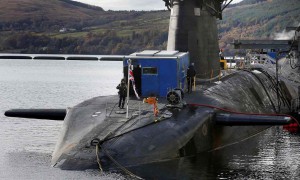Research from the Campaign for Nuclear Disarmament also suggests cost will be much higher than previously estimated
Richard Norton-Taylor
The Guardian Thursday 12 May 2016 00.01 BST
The total cost of replacing the Trident nuclear missile system will come to at least £205bn, far more than previously estimated, according to figures drawn up by the Campaign for Nuclear Disarmament (CND).
It has calculated the total on the basis of official figures, answers to parliamentary questions and previous costs of items including nuclear warheads and decommissioning nuclear reactors. It says it has not taken into account that past Ministry of Defence projects have frequently gone well over budget.
The government is expected soon to ask MPs to vote to replace the existing Trident fleet with four new nuclear submarines. The MoD has already spent nearly £4bn on the replacement programme. Last month, it declined to say how much it thought it would cost to replace Trident, and the ministry said the situation has not changed.
“The government needs a safe space away from the public gaze to allow it to consider policy options for delivering the deterrent in the most cost-effective way, unfettered from public comment about the affordability of particular policy options,” it said in response to a freedom of information request from Reuters.
In its strategic defence and security review at the end of last year, the government announced an increase from £25bn in the estimated cost of four new Trident submarines to £31bn, with an additional £10bn to cover overspends.
The Blair government’s 2006 white paper on the future of the UK’s nuclear deterrent said leasing the Trident missiles from the US until the early 2040s would cost £250m – or £350m in today’s prices, according to CND.
The white paper said Britain’s nuclear warheads would last into the 2020s but added that £3bn would be set aside to refurbish or replace the existing stockpile. That is equivalent to £4bn in today’s prices, says CND. A further £3bn (equivalent to £4bn) has been allocated for new infrastructure work at Faslane and Coulport bases.
The most expensive item would be the cumulative running costs, estimated by the government to be about 6% of the total defence budget. Crispin Blunt, Tory chair of the Commons foreign affairs committee, has calculated, on the basis of parliamentary answers, that a new Trident system would cost £167bn over a 30-year lifespan.
The cost of conventional naval forces tasked with supporting Trident was estimated in 2007 by the then government to be about £30m a year. That would total more than £1bn over the lifetime of the new Trident fleet, according to CND.
It says that while it is difficult to know how much decommissioning existing nuclear-powered Trident submarines would cost, judging by the government’s estimated spending on decommissioning Polaris, Britain’s previous nuclear weapons system, the cost of disposing the existing Trident fleet would be at least £13bn in today’s prices.
About £20bn is also being spent on the Atomic Weapons Establishment (AWE) at Aldermaston, where the warheads are manufactured and maintained, between 2000 and 2025.
Kate Hudson, CND general secretary, said: “These new calculations, drawn from actual government figures, show that the bill has spiralled beyond all expectations.”
She added: “£205 billion of public money is a huge amount. Pouring it into a nuclear weapons system that experts say could be rendered obsolete by new technology is hardly a wise choice. Far better to spend it on industrial regeneration, building homes, tackling climate change or meeting our defence needs in usable ways.”

